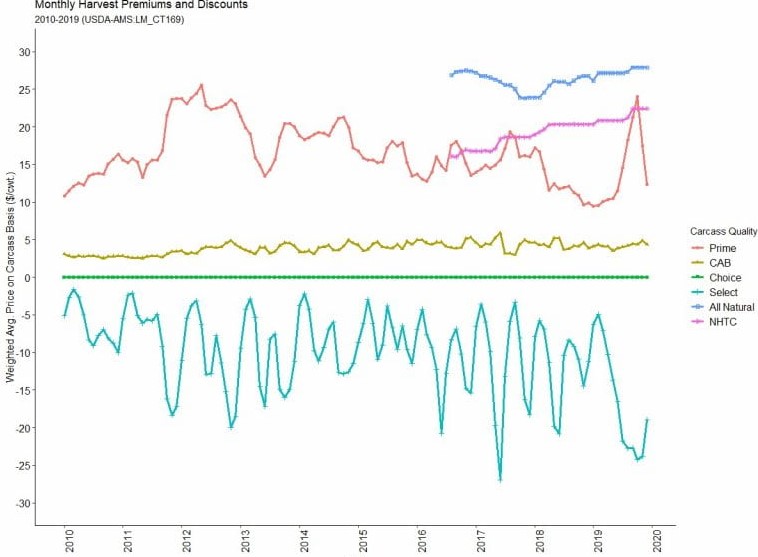By Dr. Elliott Dennis
This past year has seen several important trade agreements agreed to which will directly benefit the beef complex. The Japanese-U.S. trade deal will effectively lower tariffs for 90% of beef commodities from 38.5% to 9% between 2019 and 2033. The European Union-U.S. trade deal will increase the quota limit of hormone free beef for the U.S. to 35,000 tons (~80% of quota limit) over the next seven years. Lastly, this past week the U.S. House of Representatives voted to pass USMCA which will now go on to the Senate for final approval. This deal will continue to allow livestock products to be exported to Canada and Mexico, the two largest export destinations for U.S. livestock products.
So why has there been so much attention on securing export deals that are favorable for livestock products and in particular for beef? The short answer is because that is where demand is growing. Figure 1 clearly illustrates this story. I plot monthly data from Glynn Tonsor’s Domestic and Export Demand Indices (see Meat Demand) from 2010 to 2019 side by side. Domestic demand (left panel) for beef products fluctuates year to year but overall demand is trending sideways. Chicken has shown the largest increase in domestic demand since the late 1980’s. Export demand (right panel) tells a different story. Since 2010 export demand for beef has increased 100% and outpaced the other protein products by more than 50%. Thus, domestic demand for beef product is relatively flat but export demand for beef is sharply increasing.
Figure 1
As export demand for U.S. beef grows this signals to expand production with a yield and quality grade product that each individual country demands. Likewise, certain countries demand/require the livestock, and cattle in particular, be raised, treated, and housed in certain ways. For example, the E.U requires hormone free beef. Other countries such as China require similar regulations. For cattle to be “export eligible” they need to meet certain requirements, many of which arguably have little to do with the meat quality (i.e. yield and quality grade), flavor, and tenderness. Just as the industry has adjusted to meet domestic consumers demand for marbled products, so the industry could adopt similar practices to make more cattle export eligible.
The two certifications for cattle desired by packers are “all natural” and “non hormone treated cattle (NHTC)”. In August of 2016, the United States Department of Agriculture Agricultural Marketing Service (USDA-AMS) began reporting weekly ranges of premiums and discounts for “All Natural” and “NHTC” cattle (see LM_CT169). The NHTC premium reflects the premium for cattle that have never been treated with hormones, while the All Natural premium is applied to cattle that have never been administered hormones or antibiotics. Figure 2 plots these compared to other premiums and discounts. Clearly there is a large premium for these alternative management practices. NHTC premiums are $20 per cwt. and All Natural premiums are $25 per cwt. but premiums vary by month. Currently, both premiums have been steadily increasing over the past year. For comparison, CAB premiums were roughly $3-$5 per cwt. and constant over the past 10 years and Prime products varied but averaged $17 per cwt. over the past ten years.

Now whether it is profitable to chase NHTC and All Natural premiums depends on each operations structure, strategy, and available resources. Other protein industries have faced similar issues and opportunities and have responded. The pork industry changed in a dramatic fashion this past year by removing all ractopamine (i.e. hormone) from pork production making hogs now China export eligible. Granted China is facing African Swine Fever (ASF) and massive shortage of pork but the premiums and market share opportunity was large enough to switch production practices. The change in the beef industry will not as dramatic as the pork industry for a variety of reasons but moving forward some change in production practices is likely if the industry is going to keep up with export demand that has been sharply increasing over the last 10 years.